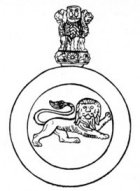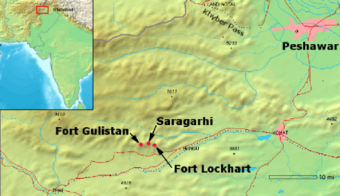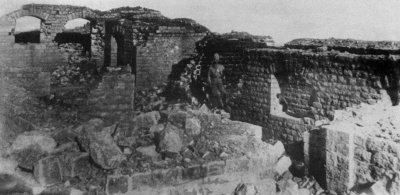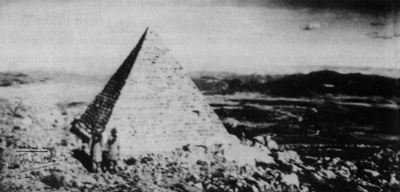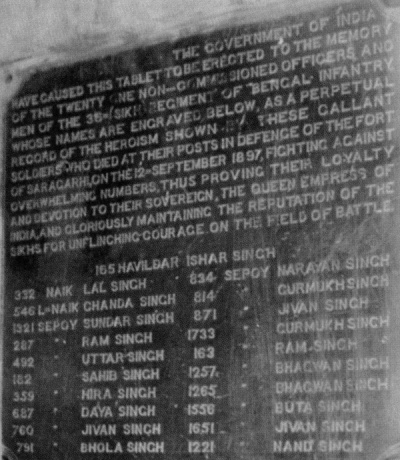Battle of Saragarhi
- Dehi Shiva Bar Mohe Ihe (O God Shiva, give me this boon)
- Shubh Karman Se Kabhun Na Taron (That I never desist from doing good deeds)
- Na Daron Ari Son Jab Jai Laron (I be fearless when I fight the enemy)
- Nischey Kar Apni Jeet Karon (And that I certainly attain victory)
- - Shri Guru Gobind Singhji
- Battle Cry: Bole So Nihal, Sat Sri Akal (He who cries God is Truth, is ever victorious).
Introduction
Saragarhi is the incredible story of 21 men of the 36th Sikh Regiment (currently the 4th Sikh Regiment) who gave up their lives in devotion to their duty. In keeping with the tradition of the Indian Army, they fought to the death rather than surrender. The Battle at Saragarhi is one of eight stories of collective bravery published by UNESCO (United Nations Educational, Scientific and Cultural Organization). It has been mentioned as one of the five most significant events of its kind in the world which includes the Saga of Thermoplyae associated with the heroic stand of a small Greek force against the mighty Persian Army of Xerxes in 480 B.C.
The Background
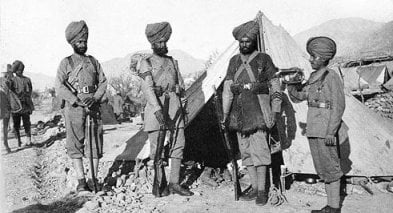
The British colonial rulers had constructed a series of forts to control the NWFP (North West Frontier Province - today a state in Pakistan) and to provide security to troops against marauding tribesmen and their lashkars (large body of troops). Most of these forts had initially been built by Maharaja Ranjit Singh as part of the consolidation of the Sikh empire in Punjab and the British added some more. The British had only partially succeeded in gaining control over this region, consequently, skirmishes and sometimes serious fights with the tribals were a frequent occurrence. However, the NWFP was a good training ground for the Indian Army to hone its skills and techniques.
Two such forts on the Samana ridge of the Hindukush & Sulaiman ranges that is Fort Lockhart and Fort Gulistan were a few miles apart. Since these forts were not inter-visible, a signalling relay post called Saragarhi was located mid-way on a bluff to provide heliographic communications between them. This post or picket had been fortified to provide safety and protection to the signalling detachment. In 1897 there was a general uprising in the NWFP engineered by Afghans as part of their policy, which came to be known as the 'prickly heat policy' to direct the wrath of the tribals against the British. In this uprising, Mullahs (Muslim religious leaders) played a prominent role. It was the duty of the 36th Sikh to occupy Gulistan and Lockhart forts. On 3rd and 9th September 1897, Orakazai and Afridi lashkars attacked Fort Gulistan. On both occasion the attacks were beaten back. A relief column was sent from the fort to assist in beating back these attacks.
The Battle
The relief column from Lockhart on the return trip reinforced the signalling detachment at Saragarhi making its strength to 1 NCO (Non-Commissioned Officer) and 20 ORs (Other Ranks). In a renewed effort, on 12 September 1897, hordes of tribesmen laid siege to Fort Lockhart and Saragarhi, with the aim of overrunning the latter and at the same time preventing any help from the former. The Commanding Officer of 36th Sikh, Lt. Col. Haughton, was at Fort Lockhart and was in communication with the Saragarhi post through helicograph. The defenders of Saragarhi under the indomitable and inspiring leadership of their detachment commander, Havildar Ishar Singh, resolved to defend their post in the best tradition of their race and regiment. They were not there to hand over the post to the enemy and seek safety elsewhere. Havildar Singh and his men knew well that the post would fall, because a handful of men in that make-shift fort of stones & mud walls with a wooden door could not stand the onslaught of thousands of tribesmen. These plucky men knew that they will go down but they had resolved to do so fighting to the last.
From Fort Lockhart, troops and the Commanding Officer could count at least 14 standards and that gave an idea of the number of tribes and their massed strength against the Saragarhi relay post (estimated at between 10,000 to 12,000 tribals). From early morning the tribals started battering the fort. The Sikhs fought back valiantly. Charge after charge was repulsed by the men of the 36th Sikh. The tribal leaders started to make tempting promises so that the Sikhs would surrender. But Havildar Singh and his men ignored them. For quite some time, the troops held their own against the determined and repeated attacks by the wild and ferocious hordes. A few attempts were made to send a relief column from Fort Lockhart but these were foiled by the tribals.
At Saragarhi, the enemy made two determined attempts to rush the gate of the post and on both occasions the defenders repulsed the assault. While the enemy suffered heavy casualties, the ranks of the defenders too kept dwindling as the fire from the attackers took its toll and their ammunition stocks were depleting. Unmindful of his safety, Sepoy Gurmukh Singh kept signalling a minute-to-minute account of the battle from the signal tower in the post to Battalion HQs. The battle lasted the better part of the day. When repeated attacks failed, the enemy set fire to the surrounding bushes & shrubs and two of the tribesmen under cover of smoke, managed to close in with the post's boundary wall in an area blind to the defender's observation and rifle fire from the post holes. They succeeded in making a breach in the wall. This development could be seen from Fort Lockhart and was flashed to the post.
A few men from those defending the approaches to the gate were dispatched to deal with the breach in the wall. This diversion by the enemy and the defenders' reaction resulted in weakening of the fire covering the gate. The enemy now rushed the gate as well as the breach. Thereafter, one of the fiercest hand-to-hand fights followed. One of the Havildar Singh's men, who was seriously wounded and was profusely bleeding, had taken charge of the guardroom. He shot four of the enemy as they tried to approach his charge. All this time, Sepoy Gurmukh Singh continued flashing the details of the action at the post. Beside this the Commanding Officer of 36th Sikh and others at Lockhart Fort also saw his unique saga of heroism and valour unfold at Saragarhi. The battle had come too close for Sepoy Gurmukh Singh's comfort, so he asked Battalion HQs for permission to shut down the heliograph and take up his rifle. Permission was flashed back. He dismounted his heliograph equipment, packed it in a leather bag, fixed bayonet on his rifle and joined the fight. From this vantage point in the tower he wrought havoc on the intruders in the post. He died fighting, but took 20 of the enemy with him.
The tribals set fire to the post, while the brave garrison lay dead or dying with their ammunition exhausted. Next morning the relief column reached the post and the tell tale marks of the epic fight were there for all to see. The tribals later admitted to figure of 180 dead and many more wounded. This episode when narrated in the British Parliament, drew from the members a standing ovation in the memory of the defenders of Saragarhi. The story of the heroic deeds of these men was also placed before Queen Victoria. The account was received all over the world with awe and admiration. All the 21 valiant men of this epic battle were awarded the Indian Order of Merit Class III (posthumously) which at the time was one of the highest gallantry awards given to Indian troops and is considered equivalent to the present-day Vir Chakra. All dependants of the Saragarhi heroes were awarded 50 acres of land and 500 Rupees. Never before or since has a body of troops - that is, all of them won gallantry awards in a single action. It is indeed a singularly unique action in the annals of Indian military history.
Wahe Guruji Ka Khalsa, Wahe Guruji Ki Fateh!
The tablet reads;
"The Government of India have caused this tablet to be erected to the memory of the twenty one non-commissioned officers and men of the 36 Sikh Regiment of the Bengal Infantry whose names are engraved below as a perpetual record of the heroism shown by these gallant soldiers who died at their posts in the defence of the fort of Saragarhi, on the 12 September 1897, fighting against overwhelming numbers, thus proving their loyalty and devotion to their sovereign, the Queen Empress of India, and gloriously maintaining the reputation of the Sikhs for unflinching courage on the field of battle."
- 165 Havildar Ishar Singh
- 332 Naik Lal Singh
- 834 Sepoy Narayan Singh
- 546 Lance Naik Chanda Singh
- 814 Sepoy Gurmukh Singh
- 1321 Sepoy Sundar Singh
- 871 Sepoy Jivan Singh
- 287 Sepoy Ram Singh
- 1733 Sepoy Gurmukh Singh
- 492 Sepoy Uttar Singh
- 163 Sepoy Ram Singh
- 182 Sepoy Sahib Singh
- 1257 Sepoy Bhagwan Singh
- 359 Sepoy Hira Singh
- 1265 Sepoy Bhagwan Singh
- 687 Sepoy Daya Singh
- 1556 Sepoy Buta Singh
- 760 Sepoy Jivan Singh
- 1651 Sepoy Jivan Singh
- 791 Sepoy Bhola Singh
- 1221 Sepoy Nand Singh
Above article extract from www.bharat-rakshak.com
Quotes
SARAGARHI, BATTLE OF, a heroic action fought by a small detachment of Sikh soldiers against heavy odds, took place on 12 September 1897 in the Tirah region of NorthWest Frontier Province (now in Pakistan). The heroes of Saragarhi, barely 22 in number, belonged to the 36th Sikhs, since redesignated as 4th Battalion of the Sikh Regiment of the Indian Army. During a general uprising of the turbulent Pathan tribals of Tirah in 1897, the battalion was deployed to defend Samana Ridge, a hill feature 8 km in length separating the Kurram and the Khanki valleys. The headquarters and four companies were located in Fort Lockhart at the eastern end of the ridge and the other four companies in Fort Cavagnari, commonly known as Gulistan, at its western end, with several smaller outposts at different strategic points. Saragarhi was a small picket perched on a rockyrib cropping up transversely across Samana Ridge halfway between Fort Lockhart and Gulistan preventing direct communication between the two bases. Overlooking both the wings, Saragarhi, manned by only 20 sepoys (riflemen) and one noncombatant sweeper under the command of Havildar (sergeant) Ishar Singh, was tactically a vital post for communication which in those days was possible only through visual signalling. The Orakzai andAfridi tribesmen, several thousand strong, attacked Gulistan twice on 3 and 9 September but were repulsed with heavy losses on both occasions. Chagrined at the reverses, they looked for a smaller target to ensure easy success. On the morning of 12 September 1897, they fell upon Saragarhi, a small square, stone block house, and surrounded it making any reinforcement to the besieged impossible. Havildar Ishar Singh and his men, undaunted by the hopeless situation they were in, fought back with grim determination. The incessant fire from the besiegers took its toll, and after a 6hourlong battle, the only soldier left alive was the signaller, Sepoy Gurmukh Singh, who had meanwhile kept the battalion headquarters informed about the situation through messages flashed by flag. At last asking for permission to stop signalling he took up his rifle to join combat. He fell fighting singlehanded. The valour and tenaciousness of the Saragarhi soldiers won wide acclaim. Each of them was posthumously awarded Indian Order of Merit (I.O.M.). Their nextofkin were each granted Rs 500 in cash and two squares (50 acres) of land. Their battalion, 36th Sikhs, also received Battle Honours. A memorial in the form of an obelisk standing on a base built with stones from the Saragarhi post was raised at the site by the government while memorial gurdwaras were built with public contributions at Amritsar and Firozpur. The Sikh Regiment celebrates 12 September every year as Saragarhi day.
Below quoted from www.info-sikh.com
The battle of Saragarhi fought by 36th Sikh (now 4 Sikh) in 1897, is an epitome of Valour, Courage, Bravery and Sacrifice. Havildar Issar Singh with 21 Other Ranks made the supreme sacrifice repulsing 10,000 of the enemy. This sacrifice was recognised by the British Parliament, when it rose to pay its respects to these brave young soldiers. All 22 were awarded the Indian Order of Merit (IOM), the then highest decoration for the Indian soldiers. This 'Kohinoor' of the Sikh Regiment is one of the ten most famous battles of the world. Even to this date, this battle forms part of the school curriculum in France. 12 September 1897, the day of the Battle of Saragarhi is celebrated as the Regimental Battle Honours Day.
The Battle of Saragarhi fought by men of 36th Sikhs in 1897, is an epitome of raw courage, sheer grit and unshakable determination. Saragarhi was a small signaling post located between Fort Lockhart and Fort Gulistan on the Samana Ridge in the N.W.F.P. On September 12, 1897 about 10,000 Afridis and Orakazais tribesmen swarmed towards Saragarhi, while another group cut off all links from Forts Gulistan and Lockhart. For the next six hours the small detachment of 22 men led by Havildar Ishar Singh stood firm and repulsed all attacks. With passage of time the ranks of the Sikhs started getting thinner and their ammunition was running out. But they never faltered and continued to punish the enemy. The enemy succeeded in making a large breach in the outer wall and swarmed in, the Sikhs fought to the last man. When the news of the battle reached London, the British Parliament rose to give a standing ovation. All the 22 men were given the posthumous award of Indian Order of Merit, Class 1, (IOM). This was the highest gallantry award given to Indian ranks in those days and was equivalent to the Victoria Cross. All dependants were given two squares of land and Rs. 500 as financial assistance and memorials were built at Ferozepore and Amritsar. The award of so many posthumous IOMs to a single group of men in one day was something unheard of and remains unparalleled in the annals of military history. After Saragarhi the tribesmen then attacked Fort Gulistan, which was held by 160 men of 36th Sikh. The fort held out until relief arrived. A group of Sikh soldiers in a daredevil attack managed to capture 3 Afghan standards ( flags). 30 IDSM's were won by the defenders of Fort Gulistan.In 1901 another battalion, composed entirely of Jat Sikhs was raised and it came to be known as 47th Sikhs (later 5 Sikh).
References
1. St. Nihal Singh, India`s Fighters. London, 1914 2. The Spokesman Weekly. Delhi, 20 September 1971 3. Portrait in Courage. D.G.P.C., Delhi
